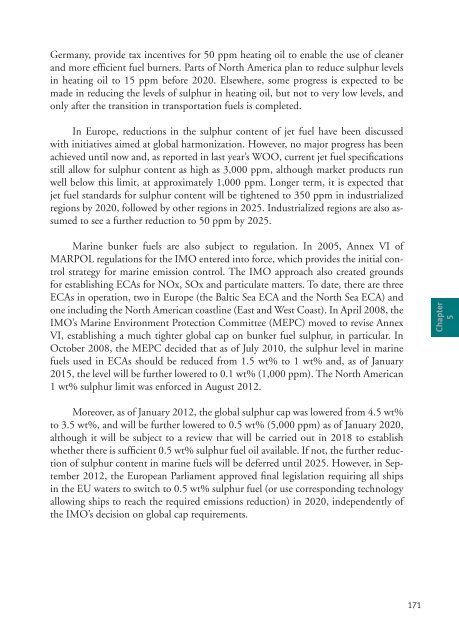World Oil Outlook - Opec
World Oil Outlook - Opec
World Oil Outlook - Opec
- TAGS
- world
- outlook
- opec
- www.opec.org
Create successful ePaper yourself
Turn your PDF publications into a flip-book with our unique Google optimized e-Paper software.
Germany, provide tax incentives for 50 ppm heating oil to enable the use of cleaner<br />
and more efficient fuel burners. Parts of North America plan to reduce sulphur levels<br />
in heating oil to 15 ppm before 2020. Elsewhere, some progress is expected to be<br />
made in reducing the levels of sulphur in heating oil, but not to very low levels, and<br />
only after the transition in transportation fuels is completed.<br />
In Europe, reductions in the sulphur content of jet fuel have been discussed<br />
with initiatives aimed at global harmonization. However, no major progress has been<br />
achieved until now and, as reported in last year’s WOO, current jet fuel specifications<br />
still allow for sulphur content as high as 3,000 ppm, although market products run<br />
well below this limit, at approximately 1,000 ppm. Longer term, it is expected that<br />
jet fuel standards for sulphur content will be tightened to 350 ppm in industrialized<br />
regions by 2020, followed by other regions in 2025. Industrialized regions are also assumed<br />
to see a further reduction to 50 ppm by 2025.<br />
Marine bunker fuels are also subject to regulation. In 2005, Annex VI of<br />
MARPOL regulations for the IMO entered into force, which provides the initial control<br />
strategy for marine emission control. The IMO approach also created grounds<br />
for establishing ECAs for NOx, SOx and particulate matters. To date, there are three<br />
ECAs in operation, two in Europe (the Baltic Sea ECA and the North Sea ECA) and<br />
one including the North American coastline (East and West Coast). In April 2008, the<br />
IMO’s Marine Environment Protection Committee (MEPC) moved to revise Annex<br />
VI, establishing a much tighter global cap on bunker fuel sulphur, in particular. In<br />
October 2008, the MEPC decided that as of July 2010, the sulphur level in marine<br />
fuels used in ECAs should be reduced from 1.5 wt% to 1 wt% and, as of January<br />
2015, the level will be further lowered to 0.1 wt% (1,000 ppm). The North American<br />
1 wt% sulphur limit was enforced in August 2012.<br />
Moreover, as of January 2012, the global sulphur cap was lowered from 4.5 wt%<br />
to 3.5 wt%, and will be further lowered to 0.5 wt% (5,000 ppm) as of January 2020,<br />
although it will be subject to a review that will be carried out in 2018 to establish<br />
whether there is sufficient 0.5 wt% sulphur fuel oil available. If not, the further reduction<br />
of sulphur content in marine fuels will be deferred until 2025. However, in September<br />
2012, the European Parliament approved final legislation requiring all ships<br />
in the EU waters to switch to 0.5 wt% sulphur fuel (or use corresponding technology<br />
allowing ships to reach the required emissions reduction) in 2020, independently of<br />
the IMO’s decision on global cap requirements.<br />
171<br />
Chapter<br />
5
















